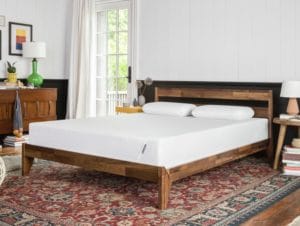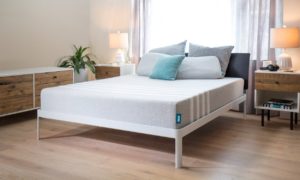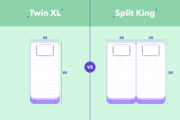Tuft & Needle vs. Leesa Mattress Reviews

The mattress industry has greatly expanded in the last two decades. If it’s been a while since you’ve bought a mattress, you might be surprised by the number of choices available. However, your goal is simple— a good night’s sleep.
To help you in your search, we’ve done a mattress comparison of Tuft & Needle and Leesa, two contenders in the foam and hybrid mattress market. They use different technologies and designs, but they both strive to provide their customers with the best rest possible. We’ll cover their strengths and weaknesses to give you an idea of whether your best mattress has one of their names on the tag.
Tuft & Needle Mattresses
 Tuft & Needle had a single model when they broke into the mattress market back in 2012. However, in 2018 they merged with Serta Simmons Bedding. They’ve since expanded their lineup with two additional models. Tuft & Needle couples the cooling power of graphite with the conformability of memory foam.
Tuft & Needle had a single model when they broke into the mattress market back in 2012. However, in 2018 they merged with Serta Simmons Bedding. They’ve since expanded their lineup with two additional models. Tuft & Needle couples the cooling power of graphite with the conformability of memory foam.
Tuft & Needle runs their own mattress stores, but their mattresses are also carried by several nationwide retailers, and they also have a few of their own brick and mortar stores. However, they primarily sell their mattress in a boxes online. You can also find a range of bedding and sleep-related furniture to create a complete Tuft & Needle bed on their website.
- The Tuft & Needle Original Mattress: In this model, a thick three-inch gel and graphite-infused foam comfort layer works with a high-density poly-foam support core to create a cooling but well-cushioned mattress.
- Tuft & Needle Mint: The Mint’s comfort layer consists of a three-inch gel and graphite-infused comfort layer that’s packed with extra graphite for better cooling than the Original. Between the top layer and support core, the Mint has a two-inch transition layer that adapts to changing sleep positions and cools with ceramic gel beads. It’s supported by the same high-density, poly-foam support core as the Original.
- Tuft & Needle Hybrid Mattress: Tuft & Needle’s Hybrid Mattress has five layers, making it the most advanced model in their lineup. The cover, which is quilted to a layer of foam, provides the first layer of cushioning and cooling. Tuft & Needle’s gel and graphite-infused foam makes up the comfort layer and covers a layer of micro-coils. These small coils rest atop another layer of foam that separates them from a pocketed coil support core. This coil-on-coil design is supported by a final thin layer of support foam.
Tuft & Needle’s Materials, Cover, and Construction
Soft, breathable polyester covers protect the Original and Mint. This cover cannot be removed and should only be spot cleaned.
The Tuft & Needle Original’s comfort layer is made of T&N (Tuft & Needle) Adaptive® foam. This unique foam blend has both gel and graphite in its formula. Graphite naturally absorbs heat, and in this design, moves that heat away from the sleeper and out of the mattress through side vents. The gel further cools the sleeper by absorbing more heat and pulling it away from the sleeper.
T&N Adaptive® foam also has a quick response to movement, cushioning and contouring the sleeper without leaving them stuck in the mattress’s surface. This cooling foam also has a cell structure that leaves space for heat and air pass through the foam while fully supporting the sleeper. Much of this model’s medium-firm feel stems from the final layer, a seven-inch, high-density poly-foam support core.
The same T&N Adaptive® foam that’s used in the Original’s top layer makes up the Mint’s three-inch comfort layer. However, The Mint’s T&N Adaptive® foam is filled with 30 percent more graphite for extra cooling power. A two-inch, poly-foam transition layer cushions the sleeper while providing stability to the conforming comfort layer. At the bottom is a seven-inch, high-density poly-foam support core. The Mint falls in the medium-firm range on a firmness scale. However, its transition layer provides extra cushioning for a softer feel than the Original.
The Hybrid’s quilted cover both cushions and cools with its open-cell poly-foam. Since it’s quilted to foam, it’s spot clean only. Two inches of T&N Adaptive® foam with gel and graphite-infused cooling properties provide a welcoming comfort layer. However, this version of T&N Adaptive® foam has carbon fiber mixed into the foam to strengthen the structure and enhance breathability.
As a transition layer, the Hybrid has micro-coils that enhance this model’s response to movement. The micro-coils also relieve pressure at pain points like the hips and shoulders. They cover a thin layer of motion absorbing T&N Adaptive® foam that does not contain graphite, carbon fiber, or gel.
The support core consists of individually-wrapped pocketed coils. Each coil compresses independently of the surrounding coils to reduce motion transfer and boost responsiveness to movement. The Hybrid’s medium-firm feel lands somewhere between the softer Original and firmer Mint.
Tuft & Needle uses CertiPUR-US® certified foams in the Original and Mint. That means they’re low in VOCs and free of harmful substances like heavy metals, ozone depleters, and chemical flame retardants. They’re also Intertek Clean Air Emissions certified, which means they aren’t a detriment to indoor air quality and give off low, if any, emissions.
The Mint is OEKO-TEX® Standard 100 certified. This certification requires extensive testing of every part of the mattress to make sure it’s free of over 300 potentially harmful chemicals. All three Tuft & Needle pass strict emissions standards to receive the GREENGUARD Gold certification, too.
Tuft & Needle’s Cooling Technology and Temperature Regulation
T&N Adaptive® foam’s open cell structure provides better breathability than traditional memory foams. The graphite and ceramic gel beads absorb heat and facilitate its movement away from the sleeper. The Mint’s higher charcoal content and cooling transition layer further enhance its cooling abilities. The Original’s temperature regulation is about average for mattresses of this type, while the Mint takes the cooling up a notch.
The Hybrid’s carbon fiber content strengthens the cell structure, improving breathability by maintaining more space for air to pass through during compression. The extra space around the micro and pocketed coils keep the air circulating, making this model the coolest of Tuft & Needle’s models.
Tuft & Needle’s Support, Conformity, and Motion Isolation
Tuft & Needle’s mattresses all rate as medium-firm on a firmness scale. However, their layer content changes the conformability and motion isolation from model to model.
The Original’s firmer feel provides enough support for back and stomach sleepers. We don’t recommend stomach sleeping due to the pressure it puts on the back. Stomach sleepers need firmer support at the hips and lighter support in the shoulders to prevent pressure from building in the lower back. Back sleepers have a more neutral spinal position, which the Original’s foam layers support with light contouring and cushioning.
The Mint’s slightly softer, medium-firm feel creates a great mattress for back, combo sleepers, and side sleepers who like a firmer mattress. A reinforced edge also prevents too much sinkage when getting into and out of the bed. However, the softer feel may leave stomach sleepers with too much arch in their backs.
The Hybrid’s gentle contouring works well for back and combo sleepers. However, the micro-coils and pocketed coils provide a firmer feel than some side sleepers may need. At the same time, the well-cushioned cover and comfort layers may allow the hips to sink too deeply for some stomach sleepers.
Tuft & Needle’s motion-absorbing foams provide a fairly quiet, motionless sleep for the most part. However, the Hybrid’s coil-on-coil design has a higher response to movement, making it the bounciest Tuft & Needle models.
Are Tuft & Needle Mattresses Durable?
Tuft & Needle mattresses contain high-quality materials and foams that show typical durability for foam and hybrid mattresses. They are all covered by a ten-year warranty that includes coverage for indentations over three-quarters of an inch. The average all-foam mattresses last about six to eight years. Hybrids push the longevity to around eight years. All three Tuft & Needle models’ lifespans should fall within those time frames or slightly longer.
Tuft & Needle’s Trial Period, Warranty, and Return Policies
Tuft & Needle provides a 100-day trial period. The mattress can be returned at any time during that period for a full refund at no cost to the purchaser. Tuft & Needle donates returned mattresses to charity.
These three models are covered by a ten-year limited warranty. During the full ten years, Tuft & Needle will repair or replace any defective components or materials. It also includes coverage for indentations over three-quarters of an inch.
The warranty does not cover normal softening of the foam or damage due to improper use. It’s also specified that the mattress must be kept on an appropriate foundation. A warranty claim can only be made by the original purchaser with proof of purchase.
Tuft & Needle’s Social Responsibility
Tuft & Needle partners with schools and offers 25 percent of proceeds for mattresses bought by parents, teachers, families, and friends of the participating school. They also partner with local charities to accept the donation of returned mattresses. In addition, they organize employee service projects in their local communities.
Who Are Tuft & Needle Mattresses For?
The budget-friendly Tuft & Needle Original mattress’s medium-firm feel does well at supporting back and stomach sleepers. The Mint’s softer three-layer design works well for back, side, and combo sleepers. The Hybrid provides a responsive mattress with a slightly stiffer but well-cushioning support. Its balance of responsiveness and cushioning provide a comfortable sleep for back and combo sleepers.
Leesa Mattresses
 Leesa, headquartered in Virginia Beach, entered the mattress market in 2014. They have their own brick and mortar stores, but the majority of their mattresses are sold online and delivered mattress-in-a-box style to your front door.
Leesa, headquartered in Virginia Beach, entered the mattress market in 2014. They have their own brick and mortar stores, but the majority of their mattresses are sold online and delivered mattress-in-a-box style to your front door.
Leesa also sells everything you need for a complete Leesa bed, including foundations, adjustable bases, pillows, mattress protectors, and bedding. Their foams are CertiPUR-US® certified, which means they’re free of harmful substances like ozone depleters, formaldehyde, and chemical flame retardants. Their three models include:
- Leesa Original: The Leesa Original has a latex-alternative comfort layer that’s supported by a memory foam transition layer. Its stability comes from a high-density, poly-foam support core. They come together in a low profile, ten-inch mattress with a medium-firm feel.
- Leesa Hybrid: The Hybrid’s comfort layer consists of an aerated latex alternative foam over a soft, conforming memory foam layer. Beneath these two is a thin poly-foam transition layer. Finally, there’s a support core made of six-inch, individually wrapped, pocketed coils.
- Leesa Legend: This model has a poly-foam comfort layer with air channels. A memory foam transition layer covers a mixed layer of zoned micro-coils and polyfoam. The pocketed coil support core is separated from the micro-coils by a thin poly-foam layer.
Leesa’s Materials, Cover, and Construction
The Leesa Original’s polyester/lycra spandex blend cover stretches with the sleeper while enhancing breathability. The comfort layer consists of two-inches of highly responsive, latex-alternative foam. This foam quickly returns to its original shape while contouring to the body rather than the snug conformity of memory foam.
However, the Leesa Original does have a memory foam transition layer that customizes the comfort to the sleeper’s shape without the heavy conformability of a memory foam mattress. The support layer consists of six inches of high-density poly-foam.
The Leesa Hybrid comes with a polyester blend cover connected to a breathable side cover. The comfort layer is made of Leesa’s highly responsive premium foam. It’s followed by a 1.5-inch memory foam layer that adds conformability without compromising the responsiveness.
A one-inch poly-foam transition layer covers the support core that’s made of six-inch, individually-wrapped pocketed coils. Pocketed coils are the same diameter from top to bottom. They’re not interconnected to reduce motion transfer.
The Leesa Legend is Leesa’s most eco-friendly option. That focus on environmental and human safety starts with an organic cotton/merino wool blend cover made entirely of recycled materials. It covers a premium, latex-like foam that contours to the body and enhances responsiveness.
Beneath it, a memory foam layer provides contouring and pressure relief. Next, a unique micro-coil layer surrounded by motion-absorbing foam cushions pressure points. This unique layer has a high-density poly-foam through the center to support the lower back. Between the micro-coils and the six-inch pocketed coil support core is a thin poly-foam transition layer.
Leesa’s Cooling Technologies and Temperature Regulation
Leesa mattresses provide excellent breathability for foam models. Aerated comfort layers and large, open-cell memory foams make space for air to move through the mattress and away from the sleeper. The coils in the Leesa Hybrid and Legend allow air to circulate, further cooling the body.
Leesa Mattresses’ Support, Conformity, and Motion Isolation
The foams of the Leesa Original absorb motion, so partners won’t be disturbed by one another. This model’s mixed-foam layers have a quick response to movement for a bouncier feel than most similar mattresses. But, it also conforms the body’s curves.
The Leesa Hybrid has good motion isolation for a hybrid model, but you should expect more bounce and response to movement than foam. It has a medium to medium-firm feel.
The foam and micro-coil zoned support of the Legend gives it a medium feel. The zoned coil/poly-foam layer provides more pressure relief than either the Leesa Original or Leesa Hybrid. The foams absorb most motion, but not as much as an all-foam or memory foam mattress.
How Durable are Leesa Mattresses?
Leesa mattresses should last about six to eight years, the industry average for this type of model. Their hybrids also fall within the average eight-year range for similar mattresses. Leesa’s 10-year warranty suggests that they, too, expect their mattresses to last about that long.
Leesa’s Trial Period, Warranty, and Return Policies
Leesa mattresses come with a 100-day sleep trial. The manufacturer requires a 30-day break-in period before a return can be started. Leesa arranges pickup accommodations. However, there is a $49 donation fee to cover the transportation cost of donating the mattress.
Leesa’s 10-year warranty includes replacement or repair for defects in materials or craftsmanship. Mattresses may be eligible for a replacement if there is an indentation greater than one inch as long as it isn’t a result of an improper foundation. The warranty does not cover damage from burns, tears, or stains. The warranty applies only to the original purchaser with proof of purchase.
Leesa allows customers to upgrade their mattresses to a newer model. The only charge is the difference in price between the two mattresses.
Leesa’s Social Responsibility
Leesa has donated over 30,000 mattresses by committing to donate one mattress for every ten sold. They also arrange for their employees to commit one percent of their time to volunteering with local organizations.
A Leesa mattress review would be incomplete without mentioning their CertiPUR-US® certified foams. Their foams have passed strict standards for content and low emissions to receive this certification.
Who Are Leesa Mattresses For?
The medium-firm support of the Leesa Original and Leesa Hybrid often provide a comfortable sleep for back, combo, and some stomach sleepers. For side sleepers, comfort will depend on sleeper weight and preferences. Some may find the medium-firm feel puts too much pressure on the shoulders or hips. Sleepers who like a quick response to movement and a bouncier mattress may also like the Leesa Hybrid.
The medium-feel Legend offers the softest Leesa option along with the best conformability. The foam layers contour and cushion while the micro-coils target pressure relief where sleepers need it most. Back and side sleepers and those who prefer a softer mattress are most likely to appreciate this model.
Tuft & Needle vs. Leesa: The Bottom Line
- Tuft & Needle and Leesa both offer budget-friendly models alongside more expensive hybrid mattresses. They also have similar warranties and life expectancies for their mattresses.
- Both have a model with micro-coils. However, Leesa uses their coil-on-coil design for zoned pressure relief while Tuft & Needle uses it for overall contouring.
- Tuft & Needle and Leesa cater to sleepers who prefer a medium to medium-firm mattress.
These two manufacturers have similar lineups. However, how they use their cooling technologies and layer construction makes a difference in how their models will feel to you. As you’re weighing your options, consider your individual circumstances, body weight, and climate. You’ve got sleep trial periods to make sure you’ve made the right choice. And remember, the right mattress for you will be the one that lets you sleep a full seven to nine hours without thinking about your mattress at all.



